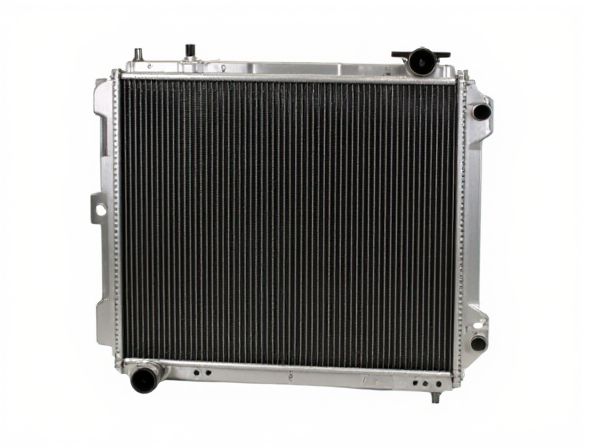
Photo illustration: Plastic Tank Radiator vs Metal Tank Radiator
Plastic tank radiators offer lightweight construction and corrosion resistance, making them ideal for long-term durability and fuel efficiency. Metal tank radiators provide superior strength and heat dissipation, enhancing cooling performance under extreme conditions. Your choice depends on balancing priorities between durability, heat transfer efficiency, and vehicle usage scenarios.
Table of Comparison
| Feature | Plastic Tank Radiator | Metal Tank Radiator |
|---|---|---|
| Material | High-strength plastic | Aluminum or brass metal |
| Durability | Moderate, prone to cracking under heat stress | High, resistant to heat and physical damage |
| Weight | Lightweight, improves fuel efficiency | Heavier, may affect vehicle weight |
| Cost | Lower manufacturing cost | Higher production cost |
| Heat Dissipation | Good, but less effective than metal | Excellent heat conduction and cooling |
| Repairability | Limited, plastic tanks often require full replacement | Better, metal tanks can often be repaired |
| Corrosion Resistance | Resistant to corrosion | May corrode if not properly maintained |
Introduction to Radiator Tank Materials
Plastic tank radiators offer lightweight construction and corrosion resistance, making them ideal for modern vehicles seeking improved fuel efficiency and durability. Metal tank radiators, typically made from aluminum or brass, provide superior heat dissipation and structural strength, benefiting heavy-duty and high-performance engines. Choosing between plastic and metal tank radiators depends on factors such as engine design, thermal requirements, and vehicle application.
Overview: Plastic Tank Radiators
Plastic tank radiators feature end tanks made from reinforced nylon or other durable polymers, offering lightweight construction and corrosion resistance compared to traditional metal tanks. These radiators provide efficient heat dissipation while reducing overall vehicle weight, which can improve fuel economy and handling dynamics. Their design allows for flexibility in shapes and sizes, enabling better integration into modern engine compartments.
Overview: Metal Tank Radiators
Metal tank radiators are known for their durability and high heat resistance, often constructed from materials such as aluminum, steel, or brass, which provide superior structural integrity compared to plastic tanks. These radiators offer enhanced thermal conductivity, allowing for more efficient heat dissipation and better engine cooling performance, especially in high-temperature or heavy-duty applications. Metal tanks also withstand higher pressure and impact, reducing the risk of leaks and extending the overall lifespan of the radiator system.
Durability and Longevity Comparison
Plastic tank radiators typically offer improved resistance to corrosion and reduced risk of leaks due to their flexible design, yet they may be more prone to cracking and UV damage over time compared to metal tank radiators. Metal tank radiators, often constructed from steel or aluminum, provide superior structural strength and heat dissipation, contributing to greater overall longevity in high-temperature environments. The choice between plastic and metal radiators impacts durability based on operating conditions, with metal tanks excelling in durability for heavy-duty applications and plastic tanks favored for lightweight, corrosion-resistant performance.
Heat Dissipation Efficiency
Metal tank radiators exhibit superior heat dissipation efficiency compared to plastic tank radiators due to their higher thermal conductivity, allowing faster heat transfer from the coolant to the surrounding air. Plastic tanks, while lighter and corrosion-resistant, act as insulators that reduce overall cooling performance. Consequently, vehicles equipped with metal tank radiators often achieve better engine temperature regulation and improved longevity under high thermal stress.
Weight and Installation Differences
Plastic tank radiators are significantly lighter than metal tank radiators, which reduces overall vehicle weight and improves fuel efficiency. The lightweight construction of plastic tanks simplifies installation, making them easier to handle and mount without requiring specialized tools or heavy lifting. Metal tank radiators, while more durable, usually require more effort and time for installation due to their heavier weight and rigidity.
Cost Analysis: Plastic vs Metal
Plastic tank radiators generally offer a lower upfront cost compared to metal tank radiators due to cheaper raw materials and simplified manufacturing processes. Metal tank radiators, such as those made from steel or aluminum, tend to have higher initial costs but provide greater durability and longer lifespan, potentially reducing long-term replacement expenses. Evaluating total cost of ownership involves balancing the lower purchase price of plastic tanks against the extended service life and repair resilience of metal tanks.
Maintenance and Repair Considerations
Plastic tank radiators offer corrosion resistance and lightweight benefits but can be prone to cracking over time, making repairs more challenging and often requiring complete tank replacement. Metal tank radiators, typically made from aluminum or brass, are more durable and easier to repair via welding or soldering for minor leaks and damage. Regular inspection and timely maintenance are critical for both types to prevent coolant leaks and ensure efficient engine cooling.
Environmental Impact and Recyclability
Plastic tank radiators typically have a lower carbon footprint during manufacturing due to reduced energy requirements compared to metal tank radiators, but their durability is often shorter, leading to more frequent replacements. Metal tank radiators, commonly made from aluminum or steel, offer greater recyclability and longer lifespan, minimizing waste and environmental impact over time. Recycling processes for metal tanks are more established and efficient, whereas plastic tanks often require specialized recycling facilities and may contribute to microplastic pollution if not properly disposed of.
Choosing the Right Radiator Tank for Your Vehicle
Choosing the right radiator tank for your vehicle involves considering durability, heat resistance, and maintenance requirements. Plastic tank radiators offer lightweight construction and corrosion resistance but may be prone to cracking under extreme heat over time. Metal tank radiators, typically made from aluminum or brass, provide superior strength and heat dissipation, making them ideal for heavy-duty or high-performance vehicles.
 caratoz.com
caratoz.com